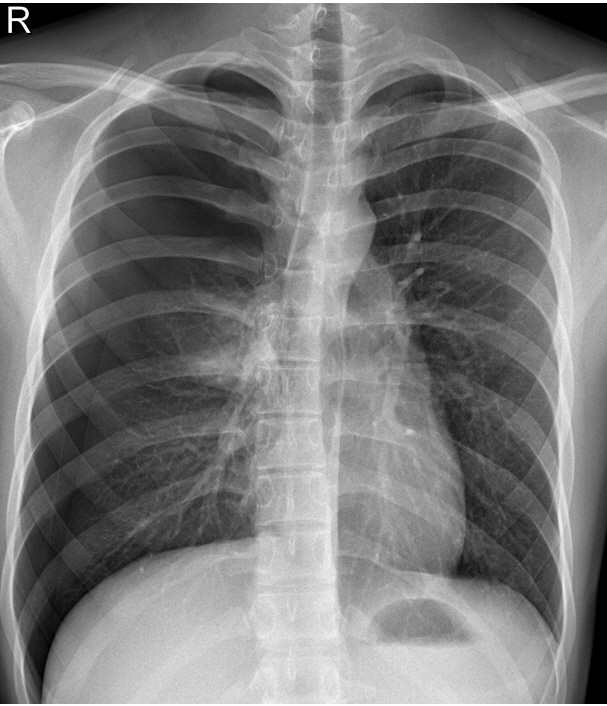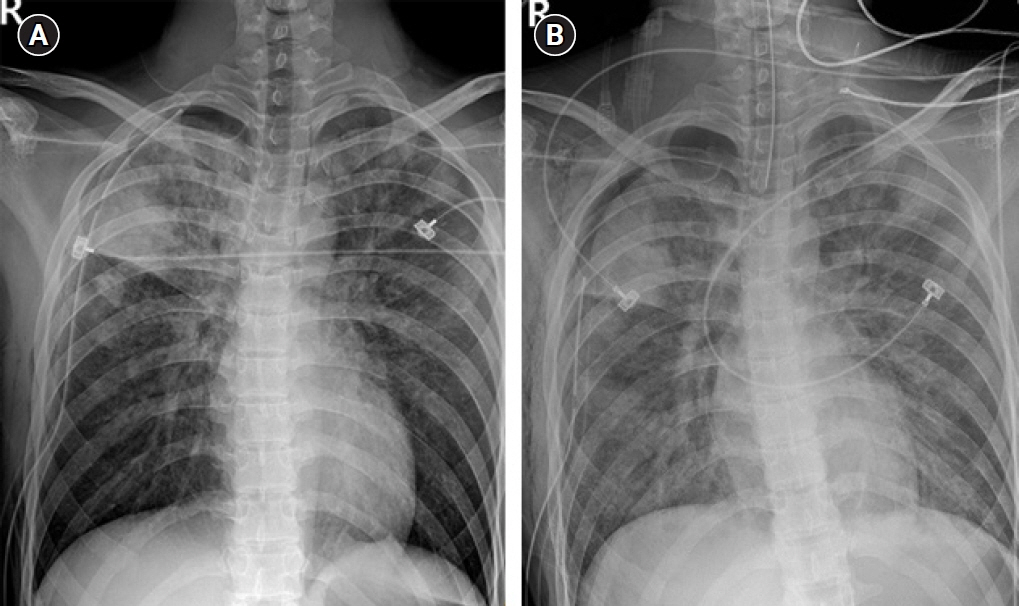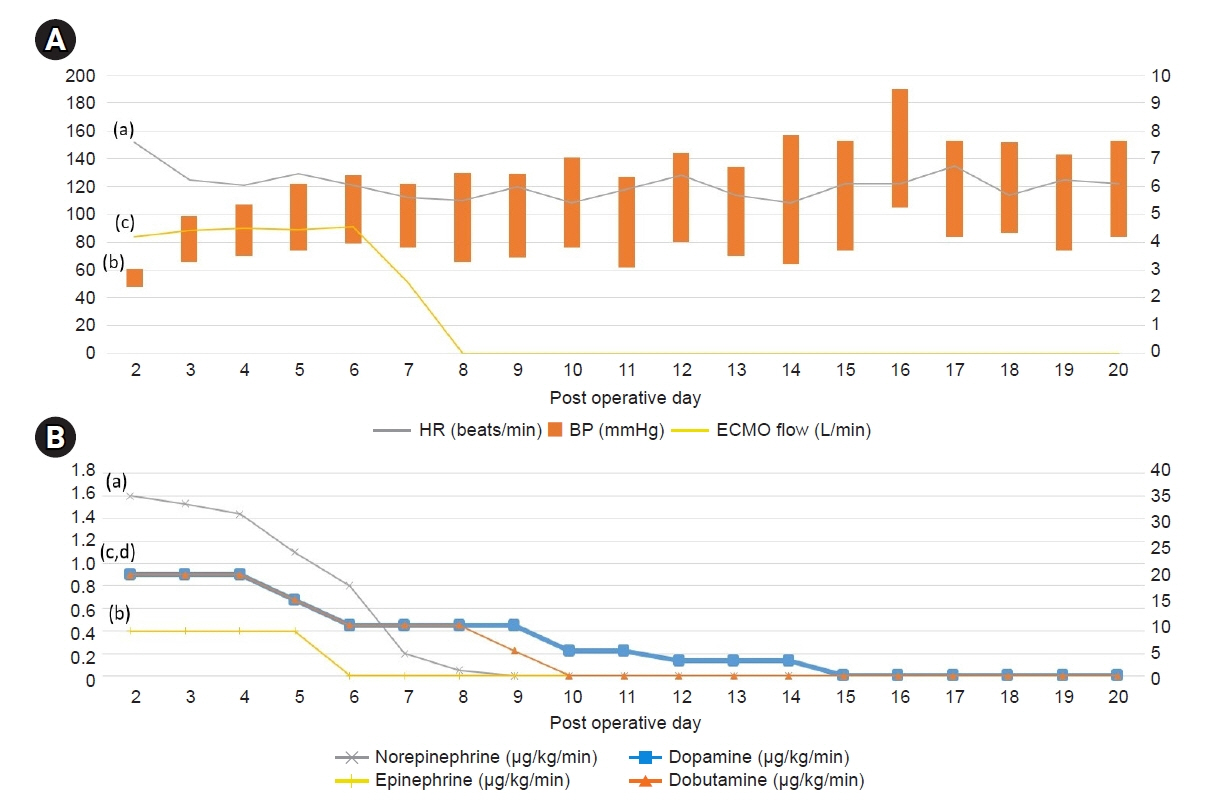Anesth Pain Med.
2022 Jul;17(3):298-303. 10.17085/apm.21116.
Unexpected pulmonary edema and cardiac arrest following wedge resection of spontaneous pneumothorax -A case report-
- Affiliations
-
- 1Department of Anesthesiology and Pain Medicine, Daejeon Eulji Medical Center, Eulji University School of Medicine, Daejeon, Korea
- KMID: 2535323
- DOI: http://doi.org/10.17085/apm.21116
Abstract
- Background
Reexpansion pulmonary edema is a rare but potentially lethal complication. We report a case of suspected reexpansion pulmonary edema that led to cardiac arrest. Case: A 16-year-old male patient underwent wedge resection due to right pneumothorax. The patient showed pink frothy sputum three hours following surgery, and a chest x-ray showed right unilateral pulmonary edema. Thirteen hours following surgery, the patient continuously showed pink frothy sputum and presented with severe hypoxemia, tachypnea, and tachycardia. After transferring to the intensive care unit (ICU), he developed ventricular tachycardia. Cardiopulmonary resuscitation was performed for 32 min. Chest X-ray showed diffuse bilateral pulmonary edema. Extracorporeal membrane oxygenation was performed. During the 65 days of ICU care, the patient became mentally alert. However, follow-up echocardiography revealed severe heart failure. Conclusions: Rexpansion pulmonary edema can rapidly progress to diffuse bilateral pulmonary edema. Therefore, careful observation is required for the patients who show signs of pulmonary edema after reexpansion.
Keyword
Figure
Reference
-
1. Sugiyama Y, Shimizu F, Shimizu S, Urasawa M, Tanaka S, Kawamata M. Severe re-expansion pulmonary edema induced by one-lung ventilation. Respir Care. 2015; 60:e134–40.
Article2. Field RR, Mai T, Hanna S, Harrington B, Calderon MD, Rinehart J. Lack of impact of nil-per-os (NPO) time on goal-directed fluid delivery in first case versus afternoon case starts: a retrospective cohort study. BMC Anesthesiol. 2019; 19:191.
Article3. Bhattacharya M, Kallet RH, Ware LB, Matthay MA. Negative-pressure pulmonary edema. Chest. 2016; 150:927–33.
Article4. Righini M, Robert-Ebadi H. Diagnosis of acute pulmonary embolism. Hamostaseologie. 2018; 38:11–21.
Article5. Sherman SC. Reexpansion pulmonary edema: a case report and review of the current literature. J Emerg Med. 2003; 24:23–7.
Article6. Matsumiya N, Dohi S, Kimura T, Naito H. Reexpansion pulmonary edema after mediastinal tumor removal. Anesth Analg. 1991; 73:646–8.
Article7. Cinnella G, Dambrosio M, Brienza N, Ranieri VM. Reexpansion pulmonary edema with acute hypovolemia. Intensive Care Med. 1998; 24:1117.
Article8. Matsuura Y, Nomimura T, Murakami H, Matsushima T, Kakehashi M, Kajihara H. Clinical analysis of reexpansion pulmonary edema. Chest. 1991; 100:1562–6.
Article9. Trachiotis GD, Vricella LA, Aaron BL, Hix WR. As originally published in 1988: Reexpansion pulmonary edema. Updated in 1997. Ann Thorac Surg. 1997; 63:1206–7.10. Sakao Y, Kajikawa O, Martin TR, Nakahara Y, Hadden WA 3rd, Harmon CL, et al. Association of IL-8 and MCP-1 with the development of reexpansion pulmonary edema in rabbits. Ann Thorac Surg. 2001; 71:1825–32.
Article11. Kasmani R, Irani F, Okoli K, Mahajan V. Re-expansion pulmonary edema following thoracentesis. CMAJ. 2010; 182:2000–2.
Article12. Yoshikawa K, Miyata M, Sueoka N, Yamamoto D. Effective steroid therapy for reexpansion pulmonary edema. JMA J. 2019; 2:97–8.
Article13. Dunham-Snary KJ, Wu D, Sykes EA, Thakrar A, Parlow LRG, Mewburn JD, et al. Hypoxic pulmonary vasoconstriction: from molecular mechanisms to medicine. Chest. 2017; 151:181–92.14. Abhishekh HA, Nisarga P, Kisan R, Meghana A, Chandran S, Raju T, et al. Influence of age and gender on autonomic regulation of heart. J Clin Monit Comput. 2013; 27:259–64.
Article15. Vazir A, Claggett B, Cheng S, Skali H, Shah A, Agulair D, et al. Association of resting heart rate and temporal changes in heart rate with outcomes in participants of the atherosclerosis risk in communities study. JAMA Cardiol. 2018; 3:200–6.
Article
- Full Text Links
- Actions
-
Cited
- CITED
-
- Close
- Share
- Similar articles
-
- Unilateral pulmonary edema following thoracotomy for the spontaneous pneumothorax
- Reexpansion Pulmonary Edema Following the Early Decompression of Pneumothorax Occurred after Anesthetic Induction in a Patient with Lung Bulla: A Case Report
- Clinical Analysis of the Surgical Treatments for Large Primary Spontaneous Pneumothorax
- Cardiac arrest caused by contralateral tension pneumothorax during one-lung ventilation - A case report –
- Adrenaline induced Cardiac Arrest and Pulmonary Edema: Two cases report





